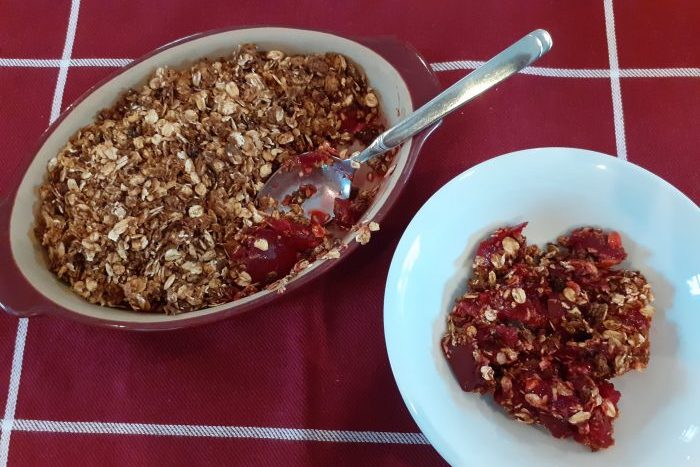Traditionally an autumnal dessert, plum crumble is a yummy pudding all year round but the usual topping is high in fat and sugar. This makeover is a great way of still enjoying a sweet favourite whilst keeping our bodies healthy. It’s delicious served with low fat plain yogurt.
Skills Check
Follow a recipe; follow food safety & hygiene rules; tidy away; cut using bridge/claw technique safely; use measuring spoons; use weighing scales; use a citrus squeezer; use a zester safely; use a hob (with adult supervision).
Equipment
Large based non-stick baking tin, small pan, sharp knife, chopping board, weighing scales, measuring spoons, zester, bowl, spoon.
Allergens (Please note the allergens listed are indicative only. Allergens vary depending on brand; check the labels on the products you use)
Oats | Gluten
Ingredients (serves 4 adults, or 8 children):
- 450g ripe plums
- 25g caster sugar
- Zest and juice of ½ orange
For the topping:
- 200g jumbo oats
- 2 tbsp honey
- ½ tsp cinnamon
- 2 tsp rapeseed oil
- Pinch of salt
Method
- Preheat the oven to 220C /Gas 6
- Put all the topping ingredients apart from the honey into a bowl and mix well to combine. Then add the honey and stir again making sure all the oats are coated.
- Spread the oat mixture out evenly on the baking sheet covered with baking paper.
- Bake for 15-20 mins until crisp and golden brown, shaking and stirring occasionally to make sure it cooks evenly.
- Meanwhile, make the filling. Halve the plums, remove the stone and put in a pan. Add the orange juice and zest and sugar.
- Cook over a medium to high heat for about 4 minutes until the sugar dissolves. Lower the heat, cover and cook for about 7 minutes until the plums are soft but still holding their shape.
- Once cooked put them in a serving dish, cover evenly with the topping and serve.
So thinking about Plumble...

Oats provide starchy carbohydrate, which gives us slow-release energy, and are a good source of fibre.
Desserts tend to be high in fat and sugar, although some types are worse than others. The Eatwell Guide says that if you are consuming food high in fat, salt and sugar we should have these less often and in small amounts.
Nutritional Information
| Energy | 1407kJ/334kcal | 17% | |
| Med | Fat | 6.3g | 9% |
| Low | Saturates | 0.8g | 4% |
| Med | Sugars | 24.0g | 27% |
| Low | Salt | 0.13g | 2% |
per 177g (adult) serving
% of an adult's reference intake
Typical values per 100g: Energy 795kJ / 189kcal
Notes
A traffic light system is used on nutrition labels to make it easier to see which foods and drinks are lower in calories, fat, sugar and salt. Try and choose more ‘greens’ and ‘ambers’ and fewer ‘reds’, and stick to smaller portions of ‘reds’.
Just because a recipe or a food has a red traffic light doesn’t mean you shouldn’t eat it. Understanding why a food or recipe might have a red light can be helpful. For example oily fish is high in total fat and so any recipe containing oily fish is likely to be ‘red’ for fat. But it is recommended that we eat oily fish at least once a week because the type of fat it contains is beneficial for our health.
% Reference Intakes are also shown. Reference Intakes are guidelines about the approximate amount of particular nutrients and energy required for a healthy diet (based on an average-sized woman doing an average amount of physical activity). Most children will require less than these Reference Intakes. The contribution of one serving of a food or drink to the Reference Intake for each nutrient is expressed as a percentage.




